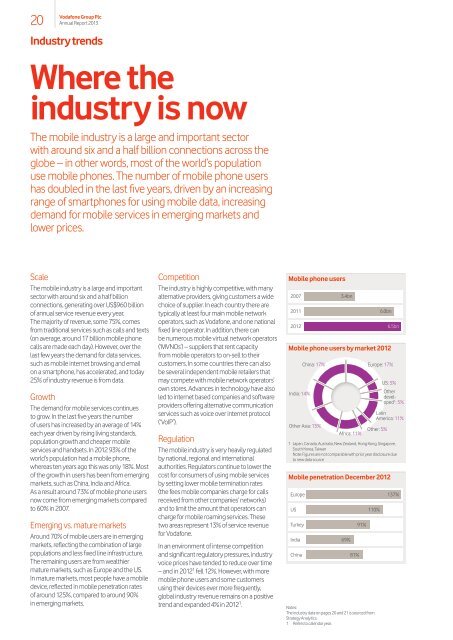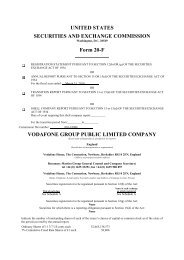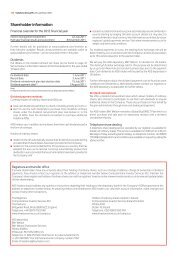The way ahead? - Vodafone
The way ahead? - Vodafone
The way ahead? - Vodafone
You also want an ePaper? Increase the reach of your titles
YUMPU automatically turns print PDFs into web optimized ePapers that Google loves.
20<br />
<strong>Vodafone</strong> Group Plc<br />
Annual Report 2013<br />
Industry trends<br />
Where the<br />
industry is now<br />
<strong>The</strong> mobile industry is a large and important sector<br />
with around six and a half billion connections across the<br />
globe – in other words, most of the world’s population<br />
use mobile phones. <strong>The</strong> number of mobile phone users<br />
has doubled in the last five years, driven by an increasing<br />
range of smartphones for using mobile data, increasing<br />
demand for mobile services in emerging markets and<br />
lower prices.<br />
Scale<br />
<strong>The</strong> mobile industry is a large and important<br />
sector with around six and a half billion<br />
connections, generating over US$960 billion<br />
of annual service revenue every year.<br />
<strong>The</strong> majority of revenue, some 75%, comes<br />
from traditional services such as calls and texts<br />
(on average, around 17 billion mobile phone<br />
calls are made each day). However, over the<br />
last few years the demand for data services,<br />
such as mobile internet browsing and email<br />
on a smartphone, has accelerated, and today<br />
25% of industry revenue is from data.<br />
Growth<br />
<strong>The</strong> demand for mobile services continues<br />
to grow. In the last five years the number<br />
of users has increased by an average of 14%<br />
each year driven by rising living standards,<br />
population growth and cheaper mobile<br />
services and handsets. In 2012 93% of the<br />
world’s population had a mobile phone,<br />
whereas ten years ago this was only 18%. Most<br />
of the growth in users has been from emerging<br />
markets, such as China, India and Africa.<br />
As a result around 73% of mobile phone users<br />
now come from emerging markets compared<br />
to 60% in 2007.<br />
Emerging vs. mature markets<br />
Around 70% of mobile users are in emerging<br />
markets, reflecting the combination of large<br />
populations and less fixed line infrastructure.<br />
<strong>The</strong> remaining users are from wealthier<br />
mature markets, such as Europe and the US.<br />
In mature markets, most people have a mobile<br />
device, reflected in mobile penetration rates<br />
of around 125%, compared to around 90%<br />
in emerging markets.<br />
Competition<br />
<strong>The</strong> industry is highly competitive, with many<br />
alternative providers, giving customers a wide<br />
choice of supplier. In each country there are<br />
typically at least four main mobile network<br />
operators, such as <strong>Vodafone</strong>, and one national<br />
fixed line operator. In addition, there can<br />
be numerous mobile virtual network operators<br />
(‘MVNOs’) – suppliers that rent capacity<br />
from mobile operators to on-sell to their<br />
customers. In some countries there can also<br />
be several independent mobile retailers that<br />
may compete with mobile network operators’<br />
own stores. Advances in technology have also<br />
led to internet based companies and software<br />
providers offering alternative communication<br />
services such as voice over internet protocol<br />
(‘VoIP’).<br />
Regulation<br />
<strong>The</strong> mobile industry is very heavily regulated<br />
by national, regional and international<br />
authorities. Regulators continue to lower the<br />
cost for consumers of using mobile services<br />
by setting lower mobile termination rates<br />
(the fees mobile companies charge for calls<br />
received from other companies’ networks)<br />
and to limit the amount that operators can<br />
charge for mobile roaming services. <strong>The</strong>se<br />
two areas represent 13% of service revenue<br />
for <strong>Vodafone</strong>.<br />
In an environment of intense competition<br />
and significant regulatory pressures, industry<br />
voice prices have tended to reduce over time<br />
– and in 2012 1 fell 12%. However, with more<br />
mobile phone users and some customers<br />
using their devices ever more frequently,<br />
global industry revenue remains on a positive<br />
trend and expanded 4% in 2012 1 .<br />
Mobile phone users<br />
2007 3.4bn<br />
2011<br />
2012<br />
Mobile phone users by market 2012<br />
India: 14%<br />
China: 17% Europe: 17%<br />
Other Asia: 15%<br />
Africa: 11%<br />
6.0bn<br />
US: 5%<br />
Other<br />
developed<br />
1 : 5%<br />
Latin<br />
America: 11%<br />
Other: 5%<br />
6.5bn<br />
1 Japan, Canada, Australia, New Zealand, Hong Kong, Singapore,<br />
South Korea, Taiwan<br />
Note: Figures are not comparable with prior year disclosure due<br />
to new data source<br />
Mobile penetration December 2012<br />
Europe<br />
US<br />
Turkey<br />
India<br />
China<br />
69%<br />
81%<br />
91%<br />
110%<br />
Notes:<br />
<strong>The</strong> industry data on pages 20 and 21 is sourced from<br />
Strategy Analytics.<br />
1 Refers to calendar year.<br />
137%











